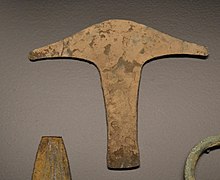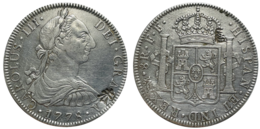This article's lead section may be too long. (December 2023) |
| History of Mexico |
|---|
 |
| Timeline |
|
|




Since the colonial era, the economic history of Mexico has been characterized by resource extraction, agriculture, and a relatively underdeveloped industrial sector. Economic elites in the colonial period were predominantly Spanish-born, active as transatlantic merchants and mine owners, and diversifying their investments with the landed estates. The largest population sector was indigenous subsistence farmers, which predominantly inhabited the center and south.
New Spain was envisioned by the Spanish crown as a supplier of wealth to Iberia, which was accomplished through large silver mines and indigenous labor. A colonial economy to supply foodstuffs and products from ranching as well as a domestic textile industry meant that the economy provided much of its own needs, with international trade mainly conducted through colonial monopolies. Crown economic policies rattled American-born elites’ loyalty to Spain when in 1804, it instituted a policy to make mortgage holders pay immediately the principal on their loans, threatening the economic position of cash-strapped landowners.[1]
The Independence of Mexico in 1821 was initially difficult for the country, with the loss of its supply of mercury from Spain in silver mines.[2] Most of the patterns of wealth in the colonial era continued into the first half of the nineteenth century, with agriculture being the main economic activity through the labor of indigenous and mixed-race peasants. The mid-nineteenth-century Liberal Reforma (ca. 1850–1861; 1867–76) attempted to curtail the economic power of the Catholic Church and to modernize and industrialize the Mexican economy. Following the Reform War and the Second French intervention, the late nineteenth century found political stability and economic prosperity during the Porfiriato (1876–1911). Mexico was opened to foreign investment and, to a lesser extent, foreign workers. Foreign capital built railway networks, one of the keys for transforming the Mexican economy, by linking regions of Mexico and major cities and ports. As the construction of the railway bridge over a deep canyon at Metlac demonstrates, Mexico's topography was a barrier to economic development. The mining industry revived in the north of Mexico, and the petroleum industry developed in the north Gulf Coast states with foreign capitals.
Regional civil wars broke out in 1910 and lasted until 1920, known generally as the Mexican Revolution. Following the military phase of the Revolution, Mexican regimes attempted to "transform a largely rural and backward country… into a middle-sized industrial power."[3] The Mexican Constitution of 1917 gave the Mexican government the power to expropriate property, which favored land reform through the creation of ejidos and the Mexican oil expropriation of 1938. Mexico benefited from its participation in World War II, and the post-war years experienced what has been called the Mexican Miracle (ca. 1946–1970). This growth was fueled by import substitution industrialization (ISI). The Mexican economy experienced the limits of ISI and economic nationalism in the 1970s. Large oil reserves discovered in the Gulf of Mexico in the late 1970s led the country to borrow heavily from foreign banks with loans denominated in U.S. dollars. When the price of oil dropped in the 1980s, Mexico experienced a severe financial crisis.
From the 1980s, Mexico implemented neoliberal economic policies and made constitutional changes to promote the private sector. The country campaigned to join the North American Free Trade Agreement, with the expanded treaty going into effect in Mexico, the U.S., and Canada on January 1, 1994. In the twenty-first century, Mexico has strengthened its trade ties with China, but Chinese investment projects in Mexico have hit roadblocks in 2014–15. Mexico's continued dependence on oil revenues has had a deleterious impact on the economy, as it happened in the 2010s.[4]
- ^ Asunción Lavrin, "The Execution of the Law of Consolidation in New Spain." Hispanic American Historical Review 52 (Feb. 1973), 27-49.
- ^ John H. Coatsworth, "Obstacles of Economic Growth in Nineteenth-Century Mexico", American Historical Review, vol. 83, no. 1 (Feb. 1978) p. 86.
- ^ Miguel S. Woinczek. "Industrialization, Foreign Capital, and Technology Transfer: The Mexican Experience, 1930–1985." Development and Change (SAGE. London, Beverly Hills, and New Delhi). Vol 17 (1986), 283–302.
- ^ Tracy Wilkinson, "Mexico, buffeted by low oil prices, cuts spending", Los Angeles Times, January 31, 2015, p. A7